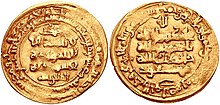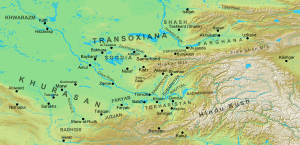Masʽud I
| Mas'ud I | |
|---|---|
| Sultan of the Ghaznavid Empire | |
 | |
| Reign | 1030–1040 |
| Predecessor | Mohammad Ghaznavi |
| Successor | Mohammad Ghaznavi |
| Born | 998 Ghazni (now in Afghanistan) |
| Died | 17 January 1041 India |
| Consort | Daughter of Abu Kalijar |
| Issue | Maw'dud Ghaznavi |
| House | Ghaznavids |
| Father | Mahmud of Ghazni |
| Religion | Sunni Islam |
Mas'ud I (Persian: مسعود), known as Amir-i shahid ("the martyr king"), was sultan of the Ghaznavid Empire from 1030 to 1040. He rose to power by seizing the Ghaznavid throne from his younger twin Mohammad, who had been nominated as the heir upon the death of their father Mahmud of Ghazni. His twin was shortly blinded and imprisoned. However, when much of Mas'ud's western domains had been wrestled from his control, his troops rebelled against him and reinstated Mohammad to the throne.
Early life
Mas'ud was born along with his younger twin brother Mohammad in 998 at the Ghaznavid capital of Ghazni. In 1015, Mas'ud was appointed as heir of the Ghaznavid Empire by his father, and was also appointed as the governor of Herat. Five years later, he led an expedition in Ghur, which was still a pagan enslave. Mas'ud later participated in the campaigns of his father in Jibal, where they managed to annex the Buyid amirate of Ray which was then under the rule of Majd al-Dawla. After Mas'ud's father left the region, Mas'ud was in charge of the Ghaznavid operations in western Iran; he continued his campaigns further west, where he managed to defeat the Kakuyid ruler Muhammad ibn Rustam Dushmanziyar, who agreed made a treaty where he agreed to recognize Ghaznavid authority.
However, Muhammad kept violating the treaty, and in 1030 wrestled Ray from the Ghaznavids. During the same period, Mahmud, because of his bad relations with Mas'ud, changed his opinion, and appointed Mohammad as his heir,[1] who was much more less experienced in government and military affairs than Mas'ud. Mahmud shortly died, and was succeeded by Mohammad. However, his uncle Yusuf ibn Sabuktigin, and the Ghaznavid army including prominent officers such as Ali Daya, were in favor of Mas'ud, whose military campaigns had earned him a great reputation.[1] Nevertheless, Mas'ud recruited a group of Turkmens to his army, which included prominent officers such as Yaghmur, Qizil, Bogha and Goktash.[2] These officers would later play an important role in the campaigns of Mas'ud.
Reign

Mas'ud then marched towards Ghazni, where he defeated his brother and had him imprisoned, while crowning himself as the new Sultan of the Ghaznavid Empire. Mas'ud shortly released the disgraced statesman Ahmad Maymandi from prison, and appointed him as his vizier. He also appointed Ali Daya as the commander-in-chief of the army of Khorasan, while another general named Ahmad Inaltigin, was appointed as the commander-in-chief of the army in India.[3]
Although Mas'ud was a great military leader, he was heedless in advice from his officers, which would later result in disastrous events during his reign.[4] He also suspected the majority of his father's officer of treaty, and even had his own uncle Yusuf imprisoned. In 1032, Ahmad Maymandi died and was succeeded by Ahmad Shirazi as Mas'ud's vizier. Sometime later, Mas'ud's governor and de facto ruler of Khwarazm, Altun Tash, was sent to invade the domains of the Kara-Khanid ruler Ali Tigin Bughra Khan, but was killed at Dabusiyya, a town near Samarkand. He was then succeeded by his son Harun.

In 1033, Mas'ud captured the fortress of Sarsut, and shortly invaded Kerman, which was then under the rule of the Buyid ruler Abu Kalijar. Mas'ud shortly managed to conquer the region, however, the inhabitants of Kerman, who preferred Buyid rule, rallied to Abu Kalijar, and under his vizier Bahram ibn Mafinna re-conquered Kerman.[5] During the same period, Ahmad Inaltigin rebelled and defeated an army sent by Mas'ud, who shortly sent another army under an Indian statesman named Tilak, who managed to rout Ahmad Inaltigin, who drowned while he was trying to escape from Tilak.[3][4] In 1033, Mas'ud married the daughter of the Ziyarid Anushirvan Sharaf al-Ma'ali's relative Abu Kalijar, who was the real ruler of the Ziyarid state.
In 1034, Harun declared independence from the Ghaznavids, and allied himself with the Kara-Khanid ruler Ali Tigin.[6] Mas'ud, however, managed to have Harun assassinated, and Ali Tigin shortly himself died. Harun was succeeded by his brother Ismail Khandan, who continued to ally with the Kara-Khanids. Meanwhile, the Seljuq Turks under the leadership of Tughril, asked Mas'ud for asylum. Mas'ud, however, considered the Turkic nomads a dangerous threat and sent an army Begtoghi, which was shortly defeated by the Seljuqs, who forced Mas'ud to cede Nasa, Farava and Dihistan in return for Seljuq recognition of Ghaznavid authority.
In 1035, Mas'ud I made another invasion of western Iran, where he defeated Abu Kalijar who had failed to pay tribute. Mas'ud then marched towards Jibal, where he once again defeated the Kakuyid ruler Muhammad, who fled to the Buyids of Ahvaz, and then to northwestern Iran, where he raised an army composing of Turkmens. In 1037/8, Muhammad, at the head of an Turkmen army, once again occupied Ray from the Ghaznavids. Meanwhile, chaos was spreading in Khorasan; the Seljuqs had begun to slowly subdue the cities of the region, and when they captured Nishapur, Tughril proclaimed himself as the ruler of Khorasan. Mas'ud, after having returned to Khorasan, expelled the Seljuqs from Herat and Nishapur. He soon marched towards Merv to completely remove the Seljuq threat from Khorasan. His army included 50,000 men and 60 or 12 war elephants. He was accompanied by his vizier Ahmad Shirazi, by his general Ali Daya, and by his officer Abd al-Razzaq Maymandi, who was the son of Ahmad Maymandi.
A battle shortly took place near Merv, known as the Battle of Dandanaqan, where the army of Mas'ud was defeated by a much smaller army under Tughril, his brother Chaghri Beg, and the Kakuyid prince Faramurz. Mas'ud thus permanently lost control of all of western Khorasan. Although Mas'ud managed to retain his capital Ghazni, he chose to leave the city, and set up a capital in India. Mas'ud, who blamed Ali Daya and other generals for the disastrous Ghaznavid defeat near Merv, had them imprisoned in India. However, the army of Mas'ud, which used to greatly hold him in high esteem, revolted against him, and had his brother Mohammad reinstated to the throne.[7] Mohammad then had Mas'ud imprisoned at Giri, where he was killed either on the orders of Mohammad or Mohammad's son Ahmed.[8] Mas'ud had a son named Maw'dud Ghaznavi, who later avenged his father by killing Mohammad, and then crowned himself as the new ruler of the Ghaznavid Empire.
References
- ^ a b Bosworth 1975, p. 187.
- ^ Bosworth 1975, p. 191.
- ^ a b Bosworth 1984, p. 647.
- ^ a b Bosworth 1975, p. 188.
- ^ Bosworth 1975, p. 189.
- ^ Bosworth 1975, p. 192.
- ^ Bosworth 1995, p. 19.
- ^ Bosworth 1995, p. 20.
Sources
- Bosworth, C. E. (1975). "The early Ghaznavids". In Frye, R. N. (ed.). The Cambridge History of Iran, Volume 4: From the Arab Invasion to the Saljuqs. Cambridge: Cambridge University Press. pp. 162–198. ISBN 0-521-20093-8.
{{cite book}}: Invalid|ref=harv(help) - Bosworth, C. Edmund (1984). "AḤMAD INALTIGIN". Encyclopaedia Iranica, Vol. I, Fasc. 6. London et al.: C. Edmund Bosworth. p. 647.
{{cite encyclopedia}}: Invalid|ref=harv(help) - Bosworth, C. E (2012). "Maymandī". Leiden and New York: BRILL. ISBN 9789004161214 http://referenceworks.brillonline.com/entries/encyclopaedia-of-islam-2/maymandi-SIM_5072?s.num=0&s.f.s2_parent=s.f.book.encyclopaedia-of-islam-2&s.q=Maymandi.
{{cite encyclopedia}}: Invalid|ref=harv(help); Missing or empty|title=(help) - Bosworth, C. E (1995). The Later Ghaznavids: Splendour and Decay: The Dynasty in Afghanistan and Northern India 1040-1186. Retrieved 9 May 2014.
{{cite encyclopedia}}: Invalid|ref=harv(help)
| Preceded by: Mohammad Ghaznavi |
Sultan of the Ghaznavid Empire Ruler 1030–1040 |
Followed by: Mohammad Ghaznavi |
